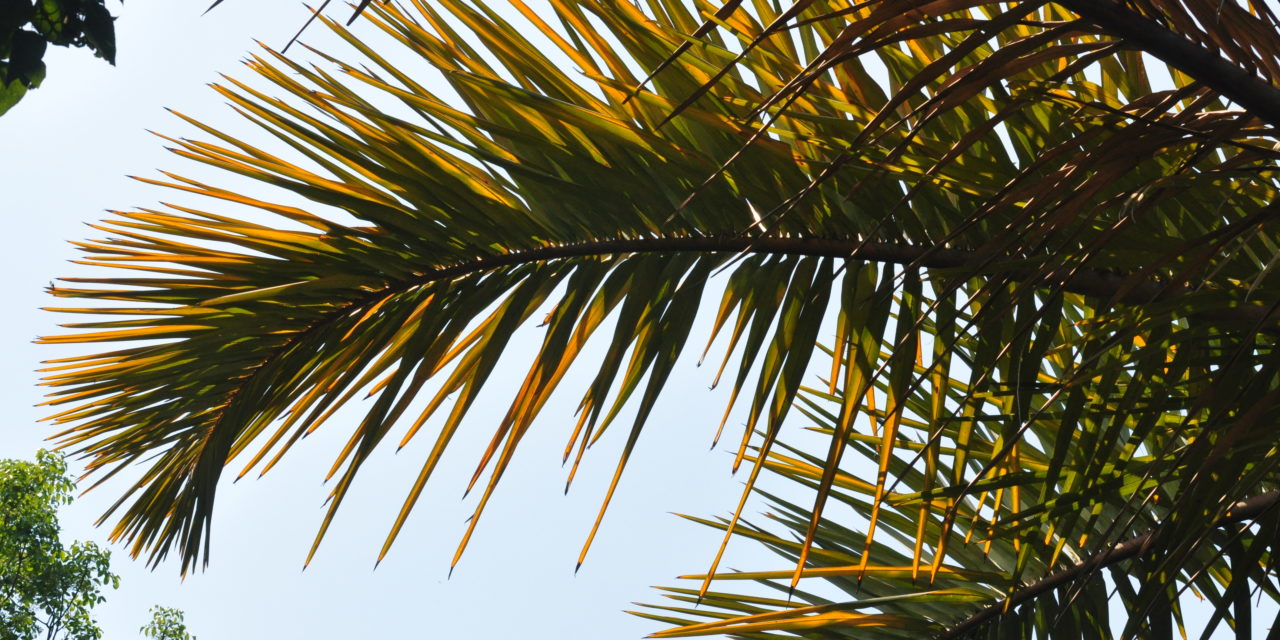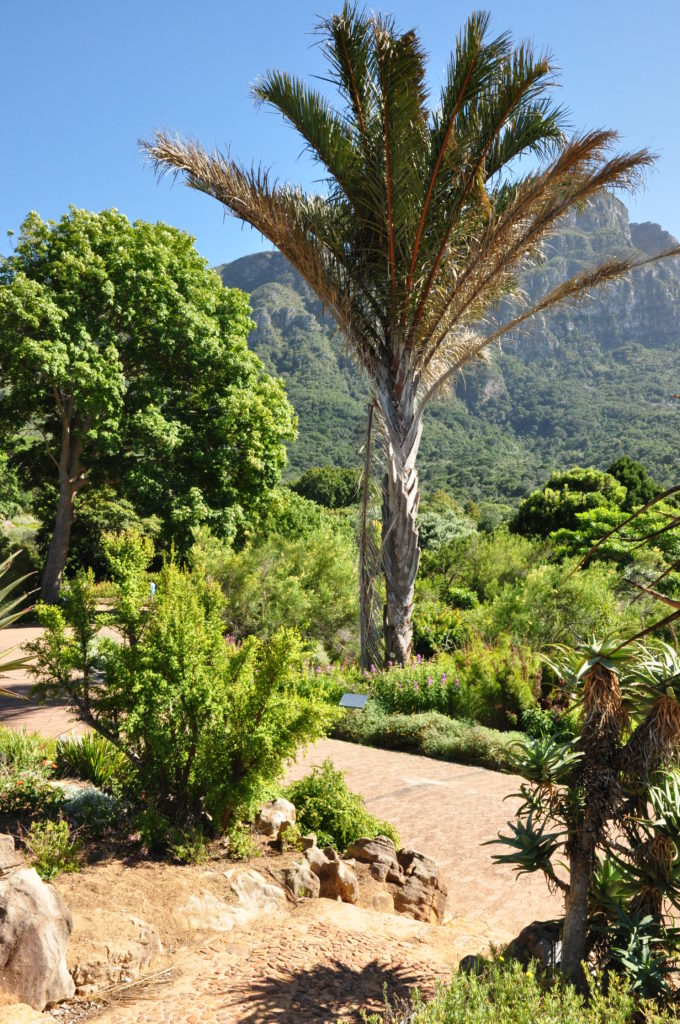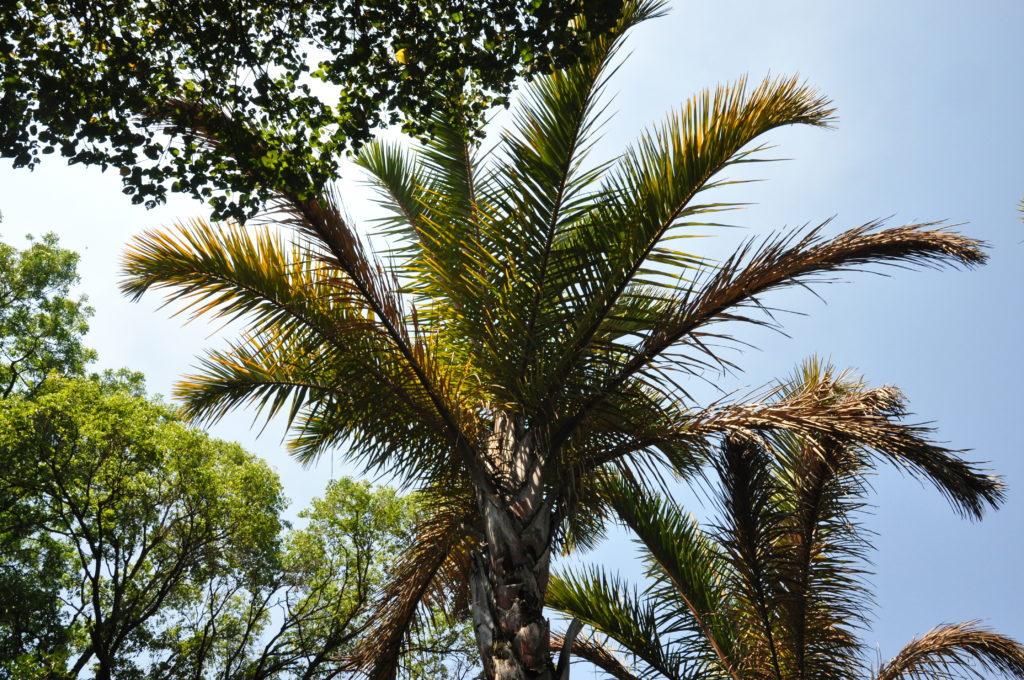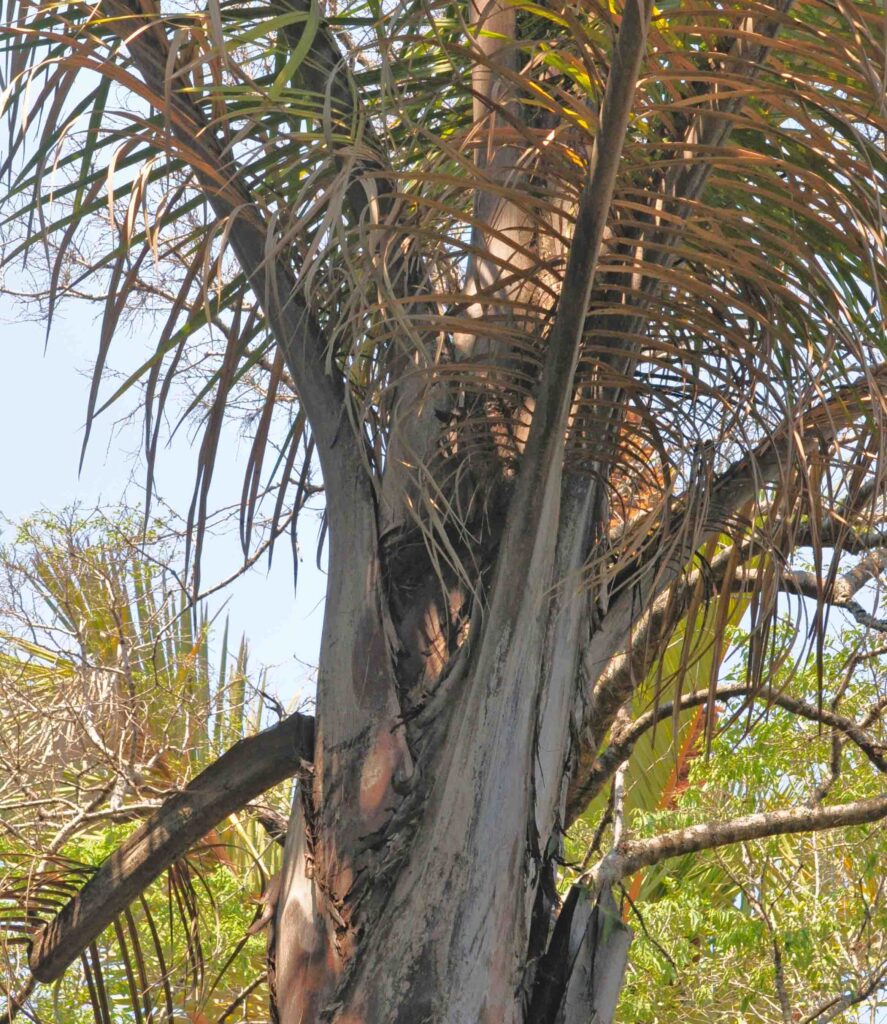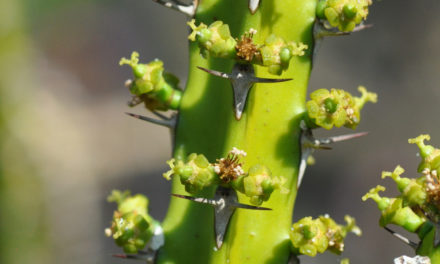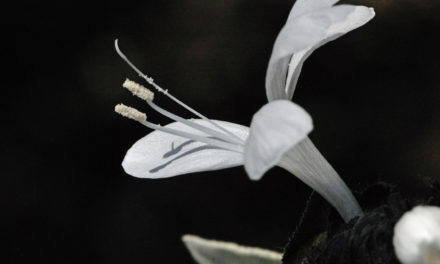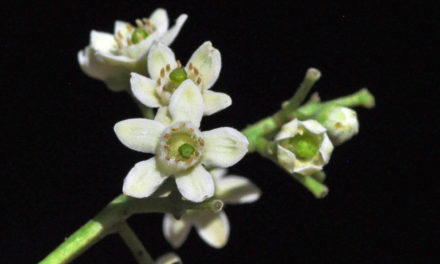General Info – summary
This rare monocarpic, unbranched and monoecious Tree may reach 24m high. Pneumatophores may be present. Pinnately compound Leaves are up to 10m long. Leaflets not reduced to spines. Old leaf bases remain. Regular unisexual Flowers develop in a 3m long terminal inflorescence. Male: 6-16 stamens. Female: 3 chambered, superior ovary + staminodes and 3 stigmas. Fruit: 9 x 5cm with 1 shiny seed.
Description
Raphia australis
SA Tree No. 26.
Common names: (Afr) Kosipalm. (Eng) Giant Palm, Kosi Palm, Kosi Raffia-palm, Southern Raphia. (isiZulu) Umvuma.
Family: Arecaceae, Palmae (Palm family). There are about 180 genera and in excess of 2 500 species in these monocotyledonous plants. The usually unbranched Trunk is covered with persistent leaf bases or with transverse scars. The tree is evergreen and mature Leaves are pinnately or palmately compound. They occur at the apex of the trunk. The Petiole or rachis is often armed with prickles. The Flowers are in a spadix (a thick fleshy spike inflorescence) surrounded by a spathe (a leaf-like curved bract). They are small and usually unisexual with male flowers in the upper part of the spadix. The 3 sepals and 3 petals are free or fused below. Male flowers usually have 6 stamens. Female flowers may have staminodes present and are usually 3-locular with 1 ovule in each. Fruit is a berry or a drupe with up to 3 seeds. In southern Africa, there are 5 genera and 6 species. Genera on this website include Jubaeopsis, Phoenix, and Raphia.
Name derivation: Raphia a needle – possibly referring to the sharply pointed fruit. australis – southern. There are about 20 species in the genus Raphia worldwide and 1 species within southern Africa.
Conservation: National Status: V R (Vulnerable). Assessed: 2016 (C.R. Scott-Shaw, L. von Staden, J.E. Victor and A.E. van Wyk). The population is characterised by an acute restriction in its area of occupancy (typically less than 100 km2). Local leaf usage is a problem. Individuals only reach maturity after 25-35 years at which point they flower and die.
Tree
The usually solitary, occasionally suckering and unbranched Tree lasts about 30 years and may reach 24m high but is usually about 16m high. The single Stem is distinct and, unlike the cycads, the protruding old leaf bases remain on the trunk (photo 149). In the angles of the lowest of these, many small rootlets may emerge and cover the bottom of the stem. These are pneumatophores (breathing roots to help cope with being water logged).
- 149. 2013/03/25. Kirstenbosch NBG. Photo: David Becking.
Leaves
Each very long arching Leaf is up to 10m in length. Leaves are pinnately compound (leaflets arranged along either side of the leaf rachis – central stalk, like a feather). Each Leaflet is linear (long, narrow leaf shape, with sides that are almost parallel with each other and usually are more than four times longer than broad – photo 621). Here the lower leaflets are not reduced to spines (photo 615). The leaflet Margins and the upper surface of the red Midrib (the main rib of a leaf or leaf-like part, a continuation of the petiole) have fine, hooked spines. The Petiole (leaf base) is unarmed. Leaflets are dark green to bluish green.
- 621. 2014/09/14. Lowveld NBG. Photo: David Becking.
- 614. 2014/09/14. Lowveld NBG. Photo: David Becking.
- 615. 2014/09/14. Lowveld NBG. Photo: David Becking.
Flowers
The plant is monoecious (having both male and female reproductive organs on the same plant) and the tree is monocarpic (the plants flowers once, set seeds and then die). Flowers develop in a Spike (simple indeterminate inflorescence with sessile flowers on a single unbranched axis opening in succession towards the apex). Here the huge spike reaches an astonishing 3m in length. It is specialised – forming a Spadix (a thick or fleshy spike) that is terminal (not in a leaf axil) and erect. The Peduncle (stalk of flower cluster, covered by 2 ranked, open overlapping bracts (bract: any leaf associated with a flower is called a bract. They may be much reduced and scale like).
Individual flowers appear after about 25 years and are actinomorphic (Regular, symmetrical. Flowers are vertically divisible into similar halves by more than 1 plane passing through the axis). Flowers are 2-ranked (male and female). The UPPER Male Flowers have 3 petals, 6-16 Stamens and lack an ovary. In the LOWER initially smaller Female Flowers, both the tubular calyx and corolla are accrescent (increasing in size with age). Stamens are absent but there is a ring of Staminodes (sterile stamens) attached to the corolla. The ovoid, 3-chambered, superior Ovary contains a single developing Ovule. The Style is short or absent and three Stigmas are present.
Fruit
The ovate or oblong Fruit develops as a triangular plume and takes about 2 years to mature. It is covered with a shiny, overlapping chest of chestnut-brown scales that are arranged in vertical rows and tipped with the remains of the 3 stigmas. Scales cover the seeds. Underneath this is a thin layer of spongy flesh that surrounds the single “ivory” seed. Each beaked fruit is up to 9 x 5cm and has a single bony seed. The fruit is scattered when the tree falls. The mature inflorescence can have an amazing mass of up to 250kg. After flowering the tree slowly dies, falls down and releases the up to 10 000 Seeds from the fruit. These seeds are covered with a thin fleshy layer – that attracts dispersal animals. The seeds germinate easily.
Distribution & Ecology
This plant is protected in the Kosi Bay section of the Greater St. Lucia Wetland Nature Reserve. It is a southern Africa endemic (restricted to a particular geographic location – here South Africa and Mozambique). These plants may occur in dense groves and have now been planted in a wider area. These fresh water trees are only located in NE KwaZulu-Natal (neighbouring Kosi Bay) and southern Mozambique (a large population within Manhica District). The tree also occurs in Gorongosa National Park in central Mozambique. It is common in drainage lines and swamp forest around Kosi Bay lakes e.g., within Lake Amanzimnyama. This is one of 4 interconnected lakes which are the preferred nesting habitat of the Palmnut vulture or vulture fish-eagle (Gypohierax angolensis), which nest in the palms and feed on the thin layer of orange flesh of the Raphia fruits. They also feed on crabs, snails, locusts and fish. In this area, the tree may be found on seasonal inundated coastal dunes. Egyptian fruit bats (Rousettus aegyptiacus) roost in the crown. These large bats have a wingspan of up to 60cm. The butterfly larvae of the Palm-tree night fighter (Zophopetes dysmephila). The adults are on wing year-round (peak Nov – May). They feed on the leaflets of this tree, Phoenix species and Dypsis lutescens in Madagascar.
Ethnobotany
The thatch like Leaves are used to build huts. The giant petioles (leaf stalks) of this plant have a low density and are suitable for raft building and for projecting structures on small boats. Seeds are quick to germinate and do best with lots of water, above zero temperatures and a low wind environment.
References
Boon, R. 2010. Pooley’s Trees of eastern South Africa. Flora and Fauna Publications Trust, Durban.
Burrows, J.E., Burrows, S.M., Lotter, M.C. & Schmidt, E. 2018. Trees and Shrubs Mozambique. Publishing Print Matters (Pty) Ltd. Noordhoek, Cape Town.
Coates Palgrave, M. 2002. Keith Coates Palgrave Trees of Southern Africa. edn 3. Struik, Cape Town.
Ginn, P.J. McIlleron, W.G. Milstein, S. 1989. The Complete Book of Southern African Birds. Struik Publishers (PTY) LTD. Third impression 1991.
Lawrence, G. H. M, 1951. Taxonomy of Vascular Plants. The Macmillan Company, New York. Tenth Printing 1965.
Palmer, E. & Pitman, N. 1972. Trees of southern Africa. Balkema, Amsterdam, Cape Town.
Scott-Shaw, C.R., von Staden, L., Victor, J.E. & van Wyk, A.E. 2016. Raphia australis Oberm. & Strey. National Assessment: Red List of South African Plants version 2020.1. Accessed on 2023/11/05.
van Wyk, B. & van Wyk, P. 1997 Field guide to Trees of Southern Africa. Struik, Cape Town.
Woodhall, S. 2020. Field Guide to Butterflies of South Africa, edn 2. Donnelley, RR, China.
https://en.wikipedia.org/wiki/Palm-nut_vulture
https://en.wikipedia.org/wiki/Raffia_palm
http://www.pacsoa.org.au/w/index.php?title=Raphia_australis
http://posa.sanbi.org/flora/browse.php?src=SP
https://www.youtube.com/watch?v=m_gkBFS9j70

